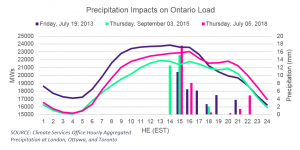 Understanding Ontario’s energy market and predicting system peak events: Part 2
Understanding Ontario’s energy market and predicting system peak events: Part 2
July 3, 2019 REDWIRE is news you can use from leading suppliers. Powered by FRASERS.
Posted by Enel X North America, Inc
Enel X North America is the preferred energy solutions partner for large commercial and industrial energy consumers acro... Read more
Subscribe
Free REDWIRE e-newsletter

Precipitation impacts on Ontario load, over a period of about five years
In this two-part article, Enel X North America discusses the importance and complexity of predicting peak electricity demand in Ontario. This second part offers more on the Industrial Conservation Initiative (ICI) and discusses allocated quantity of energy withdrawn. Read Part 1 here.
Industrial Conservation Initiative
The ICI was launched nearly a decade ago to reduce peak demand levels in Ontario by providing incentive for large industrial facilities to reduce consumption at these times. Since energy systems still do not have viable ways of storing electricity long-term, system operators must maintain the grid with sufficient resources to meet the highest-demand hours, even if much of that generating capacity remains idle most of the time. Lowering peak demand, therefore, reduces the need for new peaking power plants.
As of 2017, the IESO estimates that the ICI has reduced peak demand by 1,400 MW, which is roughly five per cent of total peak demand in Ontario. However, the amount of peak demand reduced by the ICI is not a consistent figure, and the uncertainty in the magnitude and timing of load curtailment can make peak prediction difficult. The IESO’s model, which much of the province relies on for guidance on system peak, missed two of the top five peaks this past summer. While algorithmic approaches can attempt to predict these events based on the IESO’s forecast and the historical behavior of ICI participants, certain scenarios will remain unpredictable.
Allocated quantity of energy withdrawn
A lesser-known factor complicating peak prediction is the allocated quantity of energy withdrawn (AQEW). While the IESO releases real-time system demand figures, it actually uses Verified Ontario Demand, which comes out 20 business days after a potential peak event, to determine which peak days and hours will be used to calculate customers’ GA charges.
The Verified Ontario Demand is more accurate than real-time data, and it is also adjusted for the AQEW, or the amount of energy used by hydro stations like Becks PGS and Fort Frances as well as other ancillary services. Since 2013, the AQEW adjustment has shifted load during peak periods by 300 MW to 900 MW on average. For context, in 2018, the difference between the fourth- and tenth-largest peaks was roughly 700 MW. The AQEW shifted the peak hour from its real-time placement for each of the top three peaks this past summer.
Together, these trends mean that predicting system peak events in Ontario will become increasingly complex going forward. With growing uncertainty around system peak events, energy users will need to curtail grid demand more frequently and for longer durations to have the best chance of capturing all peak hours. The ability to predict system peak events accurately – as well as access valuable resources like demand response and energy storage to maximize the value of curtailment – will be critical to keeping GA costs in control.
To learn more about how Ontario businesses are leveraging energy storage technology, read this whitepaper from Enel X, Understanding Ontario’s Energy Storage Opportunity.
To learn more, contact Enel X.
Share
Posted by Enel X North America, Inc
Enel X North America is the preferred energy solutions partner for large commercial and industrial energy consumers acro... Read more